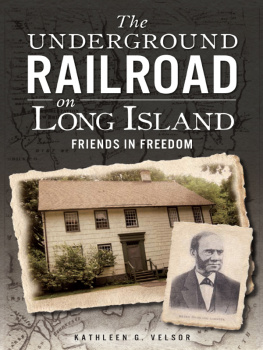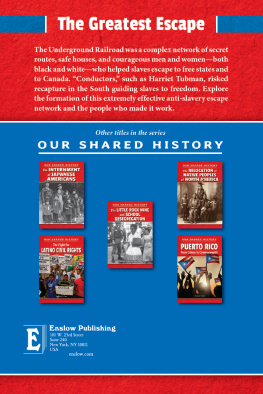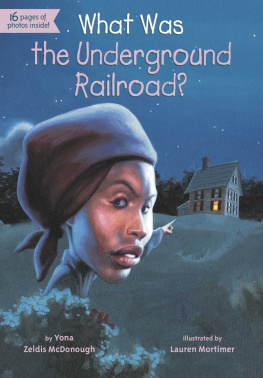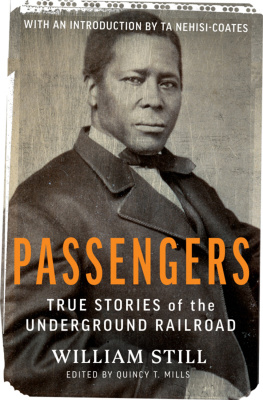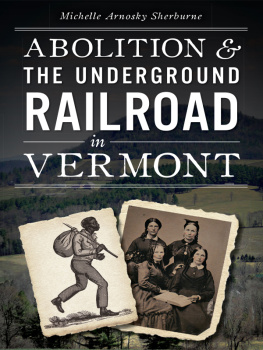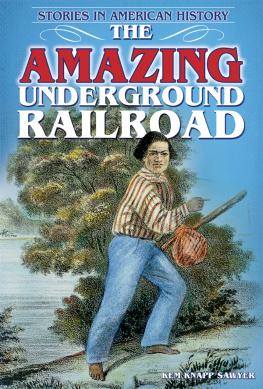
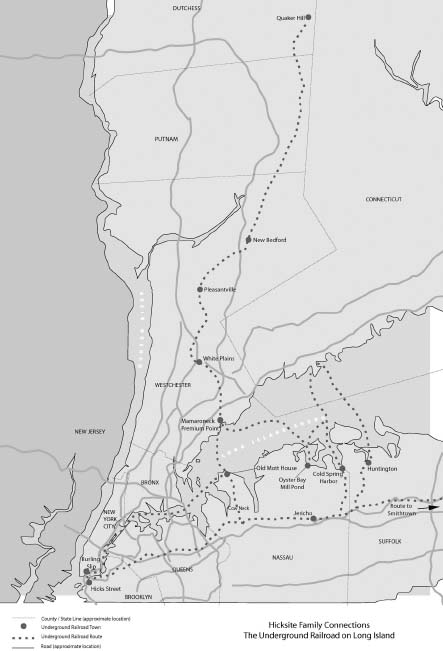
An Underground Railroad map. Desiree Fumento.

Published by The History Press
Charleston, SC 29403
www.historypress.net
Copyright 2013 by Kathleen G. Velsor
All rights reserved
First published 2013
e-book edition 2013
Manufactured in the United States
ISBN 978.1.61423.860.7
Library of Congress CIP data applied for.
print edition ISBN 978.1.60949.770.5
Notice: The information in this book is true and complete to the best of our knowledge. It is offered without guarantee on the part of the author or The History Press. The author and The History Press disclaim all liability in connection with the use of this book.
All rights reserved. No part of this book may be reproduced or transmitted in any form whatsoever without prior written permission from the publisher except in the case of brief quotations embodied in critical articles and reviews.
To my mother and father,
Doris Beal Gaffney and Matthew Watson Gaffney Sr.
CONTENTS
ACKNOWLEDGEMENTS
I am extremely appreciative of the many people who have opened their hearts and minds to me during the course of my research on the Underground Railroad on Long Island. I have had the opportunity to meet and work with many kind and generous people who have given their time to share stories and opened their homes and private collections to me in anticipation that I would share their family stories.
I am extremely grateful to Jim Driscoll and Richard Hourahan from the Queens Historical Society and to Dr. Wini Warren and Terry Walton from Rosalie Inc. Productions for their encouragement in the early phases of my research. I am thankful to my sister, Dr. Margaret G. Benedict, director of the Matthew W. Gaffney Foundation, for her spirit and encouragement to write this book. The many hours of conversation spent with Leon Rushmore from the Westbury Friends Meeting will always be precious to me. He was truly a Friend, sharing valuable information so that I could pass it on to others. I was truly honored to have known Jean Renison, curator, who was always giving me ideas to help direct my research using the documents at the Westbury Historical Library. I very much appreciate the assistance of Dr. Christopher Densmore from Swarthmore College Library; thank you for always answering my questions. Thanks to Dr. Lynda Day, professor at Brooklyn College, for sharing the letter from Wilmer about the Underground Railroad on Long Island. Thanks to Doris Pallet for knowing about the secret door at the Maine Maid Inn. Sincere appreciation goes to Robert MacKay and Charla Bolton, from the Society for the Preservation of Long Island Antiquities, for taking the initiative to work with the Village of Old Westbury and save the Old Place.
Many thanks to Kathryn and Thomas Abbey, members of the Jericho Friends Meeting, for their encouragement and support; Betsey Murphy, Jericho Library, for her continual help and knowledge about Jericho; Michael Butkewicz, Nassau County Parks, for his guidance and assistance to view the grounds of the Jericho Preserve; Marty Schackner, Nassau County Parks, who graciously opened the doors to the Elias Hicks House and the Jackson/Malcolm Home; and Ellen and Rich Benson, who opened their home on Mill Hill, told many stories and provided me with the opportunity for photographs.
Thanks to Jennifer McHugh from the Wantagh Library; members of the Nassau County Archives; the Oyster Bay Historical Society; the Rheese Library, University of Rochester; the Frederick County Historical Society; and the Guilford College Library Friends Collection in Greensboro, North Carolina.
Special appreciation goes to the State University of New YorkOld Westbury and the College Foundation for granting numerous research grants to travel and document the stories of the Underground Railroad on Long Island. Thanks also go to the members of the Underground Railroad Teaching Partnership for their encouragementDesiree Fumento for the map of the Underground Railroad; Gerri Faivre, head of Westbury Friends School; and Suzy Shechtman of Schechtman Productions. Special thanks go to Michael Kinane, assistant to the president for advancement, for his continuous support of this research and to Dr. Calvin O. Butts III, president of the College of Old Westbury and senior pastor at Abyssinian Baptist Church, for his continual interest and support of this project.
Most of all, thanks to my husband, Curtis F. Velsor Jr., whose Quaker family roots helped to open doors to the hidden records and secret stories of the work of the early Long Island Quakers. I greatly appreciate Curts encouragement. He has traveled every road, talked to numerous historians, looked for documents, searched for hidden records and papers, climbed ladders, taken photographs and listened to every story many times. Thank you.
INTRODUCTION
The story of the Underground Railroad on Long Island is the story about two groups of people. One story is about the formation of the Society of Friends, first in England and later on Long Island. The other story involves the capture and sale of the Africans and their transport to the early settlers in New York. Both stories are about oppression and the search for independence that brought them to Long Island.
As a young child, I lived in a small town in upstate New York. I remember hearing stories about the Underground Railroad and finding them fascinating. Forty years later, while researching this topic at the Long Island Studies Institute, I was handed a copy of a Xerox letter addressed to Wilmer and dated August 4, 1939, seen here and also transcribed:
Laurel Hill Road
Northport, N.Y., 8/4/39
Dear Wilmer:
Im returning that very remarkable book. Quaker Hill. Lay it aside to read when thee has time. So many names I know. There is my Aunt Phebe J Wanzer, there father of David Irish. His home was the last Station on the Underground R.R. My mothers home, Joseph Carpenter of New Rochelle, was the first Station out of New York City. My fathers, Joseph Pierce, Pleasantville, was the second Station. Judge John Jay, Bedford, was the third station, this aunts home. David Irish, Quaker Hill was the fourth Station. At that place60 miles from N.Y. the fugitives were far enough on the way to Canada, to find their way safely. These Quakers were the force that finally got the Yearly Meeting to decide that no Friend could hold slaves. And yet the writer of the book is so far from understanding of the great mind that he is dealing with that he tells us those people live in a mental attitude of make believe.

Letter to Wilmer from Jonathan, August 4, 1939. Haviland Records Room, Swarthmore College Library.
Many questions came quickly to mind. Where is Quaker Hill? Who was David Irish? Is Jonathans last name Pierce? What I discovered was that I was as equally enthralled with this period of history in 1994 as I was as a child. Since then, I have written numerous grants to prove that Long Island Quakers were involved in the Underground Railroad. Throughout my travels, I have met many historians and collected numerous letters and original notes from universities, historical collections and private sources. I have found that these stories were recorded by early abolitionists and freedom seekers and were even hidden in numerous locations. My quest has been challenging, and it helped me to conclude that many families helped to establish a freedom trail running throughout Long Island. The struggle for freedom was not guaranteed, but it was fought by many. This work intends to retell the stories of the many people who worked to help others to circumvent oppression.
Next page
